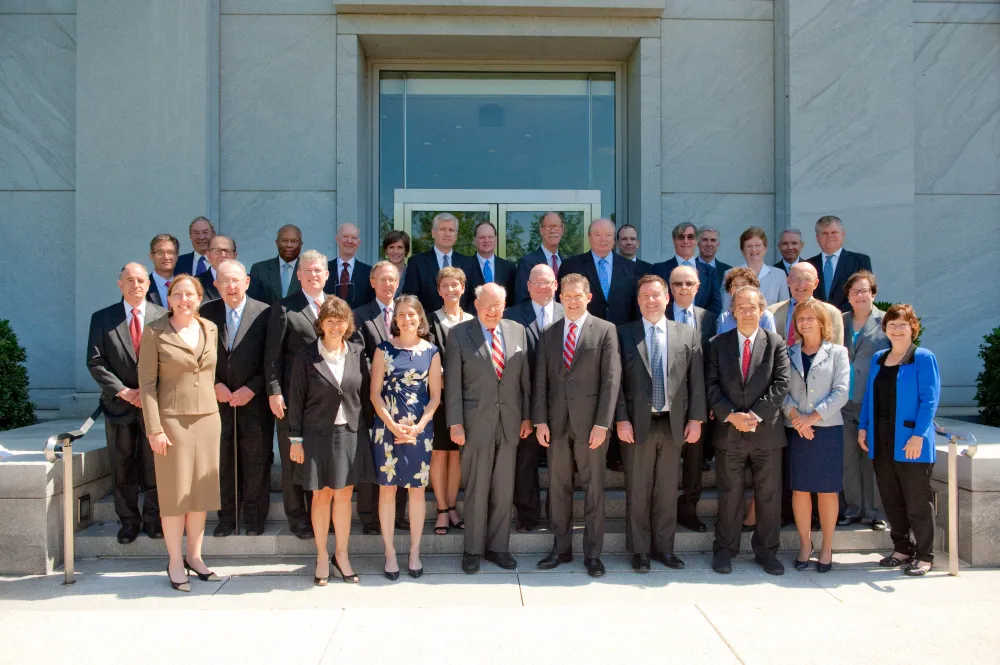The Federal Rules of Practice and Procedure govern practice in the federal courts. The Judicial Conference Committee on Rules of Practice and Procedure (Standing Committee) and its five advisory rules committees carry on a continuous study of the operation and effect of the federal rules as directed by the Rules Enabling Act.

Meeting of the Committee on Rules of Practice and Procedure in June 2016 in Washington, DC.
Newly Adopted Federal Rule Amendments
In April 2016, the Supreme Court adopted and transmitted to Congress amendments to the following rules and forms:
- Appellate Rules 4, 5, 21, 25, 26, 27, 28, 28.1, 29, 32, 35, and 40; Forms 1, 5, and 6; new Form 7; and a new appendix;
- Bankruptcy Rules 1010, 1011, 2002, 3002.1, 7008, 7012, 7016, 9006, 9027, and 9033, and new Rule 1012;
- Civil Rules 4, 6, and 82; and
- Criminal Rules 4, 41, and 45.
Congress took no action to modify or reject these Supreme Court-approved amendments, and the amendments took effect on December 1, 2016. Amendments to Appellate Rule 26(c), Bankruptcy Rule 9006(f), Civil Rule 6(d), and Criminal Rule 45(c) eliminate the so-called three-day rule in cases of electronic service. The three-day rule adds three days to a given period if that period is measured after service and service is accomplished by certain methods. A subcommittee charged with overseeing an integrated approach to issues arising from electronic filing recommended that the three-day rule be amended to exclude electronic service. The resulting amendments accomplish that and represent an ongoing effort by the advisory rules committees to identify and coordinate proposed rule changes that have implications for more than one set of rules.
The changes to the Appellate Rules are the culmination of several projects undertaken by the Advisory Committee on Appellate Rules. Amendments to Appellate Rules 4(c)(1) and 25(a)(2)(C); and Forms 1 and 5 and a new Form 7 clarify and improve the inmate-filing rules. Another significant project undertaken by the committee was to address length limits set by the Appellate Rules for briefs and other documents. Page limits were converted to word limits in Rules 5, 21, 27, 35, and 40 for documents, other than briefs, that are prepared using a computer. Word limits for briefs changed from 14,000 to 13,000; the word limit for a reply brief changed from 7,000 to 6,500 words. New Rule 32(f) sets out a uniform list of the items that can be excluded when computing a document’s length, and a new appendix collects in one chart all length limits stated in the Appellate Rules. The local variation provision in Rule 32(e) remains—courts of appeals retain the authority (by local rule or by order in a case) to accept longer briefs and other documents.
The amendments to Criminal Rule 41 address venue for obtaining warrants for certain remote electronic searches by including two additional exceptions to the list of out-of-district searches permitted under Rule 41(b): 1) when a suspect has used technology to conceal the location of the media to be searched; or 2) in an investigation into a violation of the Computer Fraud and Abuse Act, 18 U.S.C. 1030(a)(5), when the media to be searched include damaged computers located in five or more districts. Rule 41(f)(1)(C) was also amended to specify the process for providing notice of a remote access search. The amendments are procedural in nature and are meant to clarify venue requirements; the amendments do not alter the constitutional requirements for the issuance of a warrant.
Pending Rules Amendments
On September 13, 2016, the following amendments proposed by the Judiciary Conference’s Standing Committee were approved by the Conference and have been transmitted to the Supreme Court:
- Bankruptcy Rules 1001, 1006(b), and 1015(b); and
- Evidence Rules 803(16) and 902.
If the Supreme Court approves the proposed amendments, they will be transmitted to Congress by May 1, 2017. Barring congressional action to modify or reject the proposals, the amendments will take effect on December 1, 2017.
Proposed Rules and Forms Amendments Published for Public Comment
In July 2016, the Standing Committee approved publication of proposed amendments to Bankruptcy Rule 3015 and proposed new Bankruptcy Rule 3015.1 for a comment period from July 1, 2016 through October 3, 2016.
In August, the Standing Committee approved publication of proposed amendments to the following rules and forms for a comment period from August 12, 2016, through February 15, 2017:
- Appellate Rules 8, 11, 25, 28.1, 29, 31, 39, and 41; and Form 4;
- Bankruptcy Rules 3002.1, 5005, 8002, 8006, 8011, 8013, 8015, 8016, 8017, new Rule 8018.1, 8022, and 8023, and new Part VIII Appendix; and Official Forms 309F, 417A, 417C, 425A, 425B, 425C, and 426;
- Civil Rules 5, 23, 62, and 65.1; and
- Criminal Rules 12.4, 45, and 49.
The agenda books of the standing and advisory committees are published online for public access, as are committee reports, meeting minutes, and other resource materials. Notices of the time and place of the committees’ meetings and hearings are published in the Federal Register.
Annual Report 2016
- Annual Report 2016
- Funding/Budget
- The Courts and Congress
- The Federal Bench in 2016
- Accountability and Resource Management
- Facilities and Security
- Public Outreach
- Court Operations and Case Management
- Defender Services
- Probation and Pretrial Services
- Human Resources
- Information Systems and Cybersecurity
- Recent and Proposed Amendments to the Federal Rules
- In Profile
